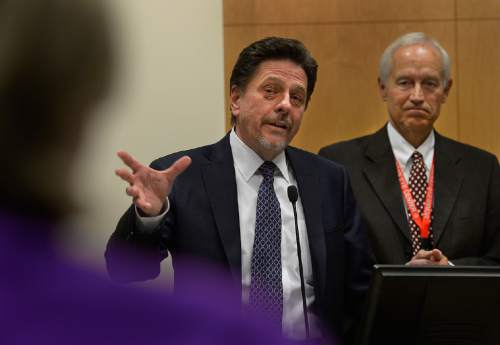This is an archived article that was published on sltrib.com in 2015, and information in the article may be outdated. It is provided only for personal research purposes and may not be reprinted.
Randall Olson perhaps engaged in a bit of hyperbole last February when he said that Moran Eye Center researchers would work in a "literally seamless" way with researchers from Allergan Inc.
The University of Utah, after all, sets boundaries between researchers and sponsors of research such as the California pharmaceutical giant.
No private company employee is allowed to work in a university lab except under special circumstances, says Tom Parks, the U.'s vice president of research. Allergan doesn't have a special circumstance.
Neither will Allergan or any company have access to the 5,000 pairs of eyeballs Moran researcher Gregory Hageman has been amassing over his career, most of which he brought to the U. three years ago, Parks says.
More than 2,000 of the pairs of eyes were donated in Utah, and the entire repository is now the property of the U.
Allergan also will have no access to the Utah Population Database, a genetic treasure trove built, in part, on genealogical records from The Church of Jesus Christ of Latter-day Saints.
It can only be used by faculty. Those who want detailed access must obtain approval of a committee that includes representatives of the state and the church.
It is Hageman's lab, the Center for Translational Medicine, that landed the Allergan deal, and is working to identify an enzyme that would enable Allergan to develop a drug. The intent is to block age-related macular degeneration, a leading cause of blindness, from developing.
The lab is by far the biggest at the Moran Eye Center, with 50 employees. Allergan is paying the U. for each milestone Hageman's lab reaches, although neither party will disclose the total value of the five-year partnership.
The average biomedical corporate-sponsored research deal in 2013 was worth $8.5 million, and the Allergan deal, closed at the end of that year, apparently was not far from the average.
Allergan is paying only about half of the costs of Hageman's lab, Olson says. He is raising the rest from donors.
The university and Allergan will jointly hold any patents arising from joint research, and the U. and Hageman's startup company, Voyant Biotherapeutics, will make money if Allergan comes up with a successful drug. Hageman's company also gave the U. shares of its stock, although Voyant essentially is a shell company with no assets, Olson says.
The U.'s conflict-of-interest policy requires all faculty to disclose financial or commitment conflicts (theirs or their families') to their supervisors. A university-wide Conflict of Interest Committee decides whether the conflict needs active oversight, and in those cases, the faculty member's supervisor develops a management plan to stay on top of it.
The School of Medicine has a detailed policy restricting ties with companies and spelling out the ethical standards for what is a common relationship — a doctor running a clinical trial for a company.
kmoulton@slrib.com Twitter: @KristenMoulton



